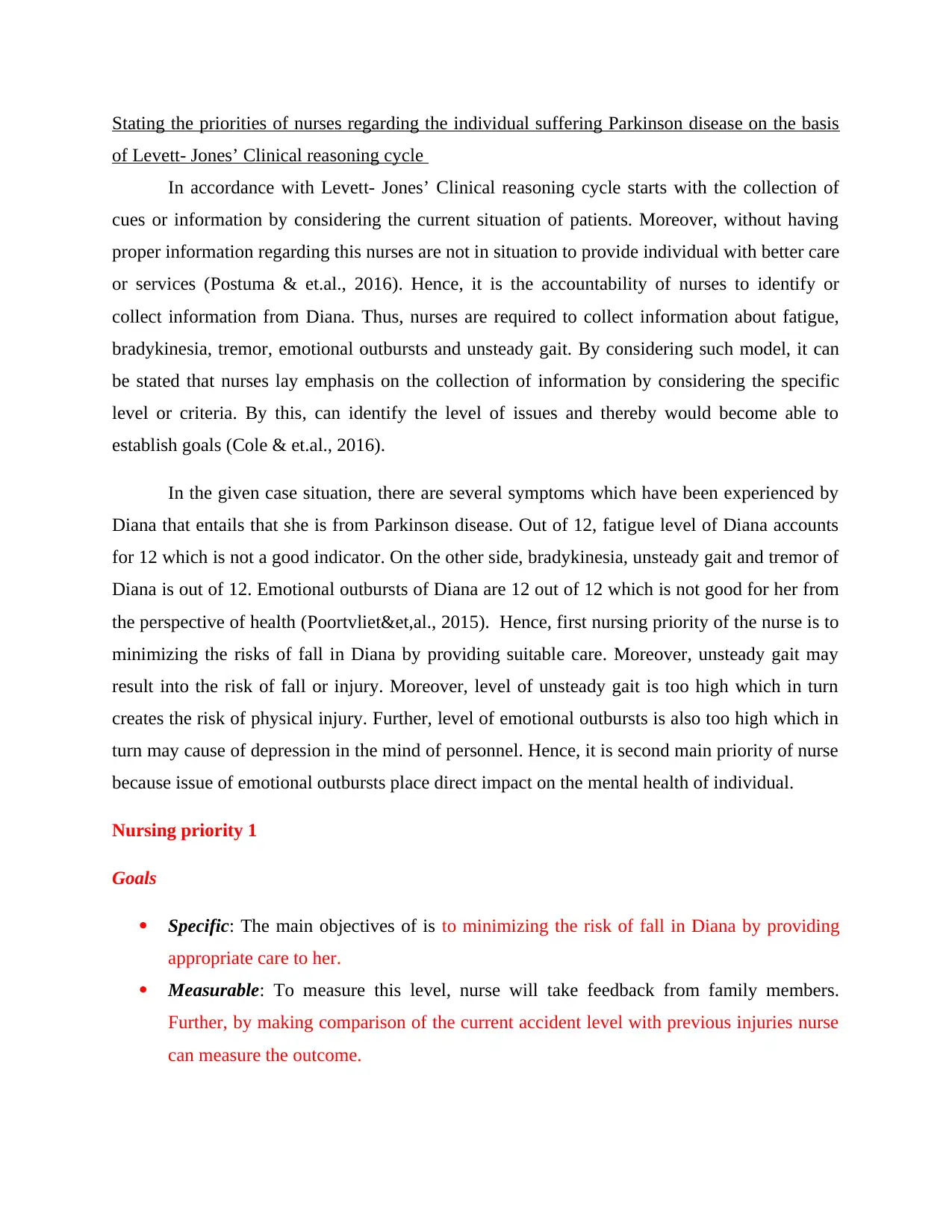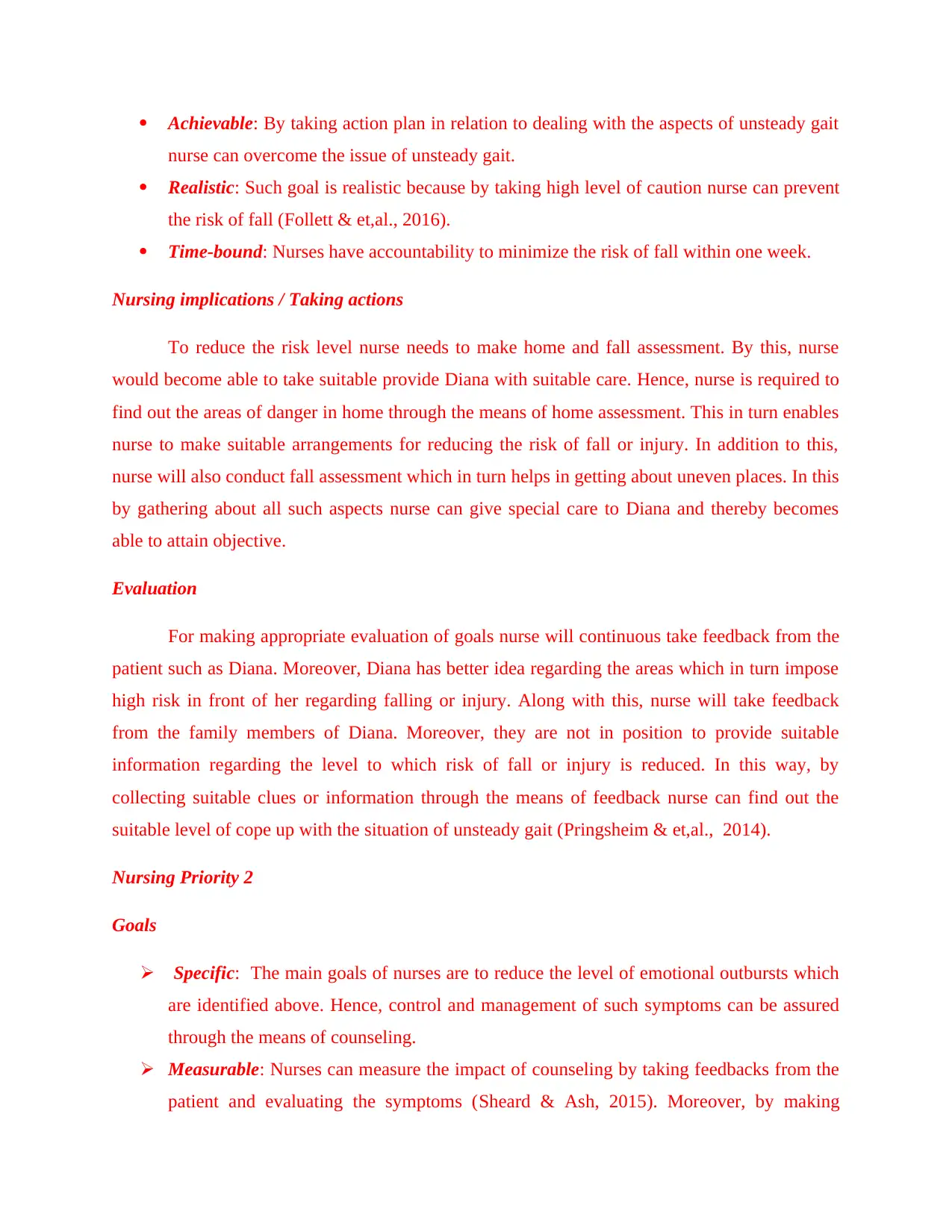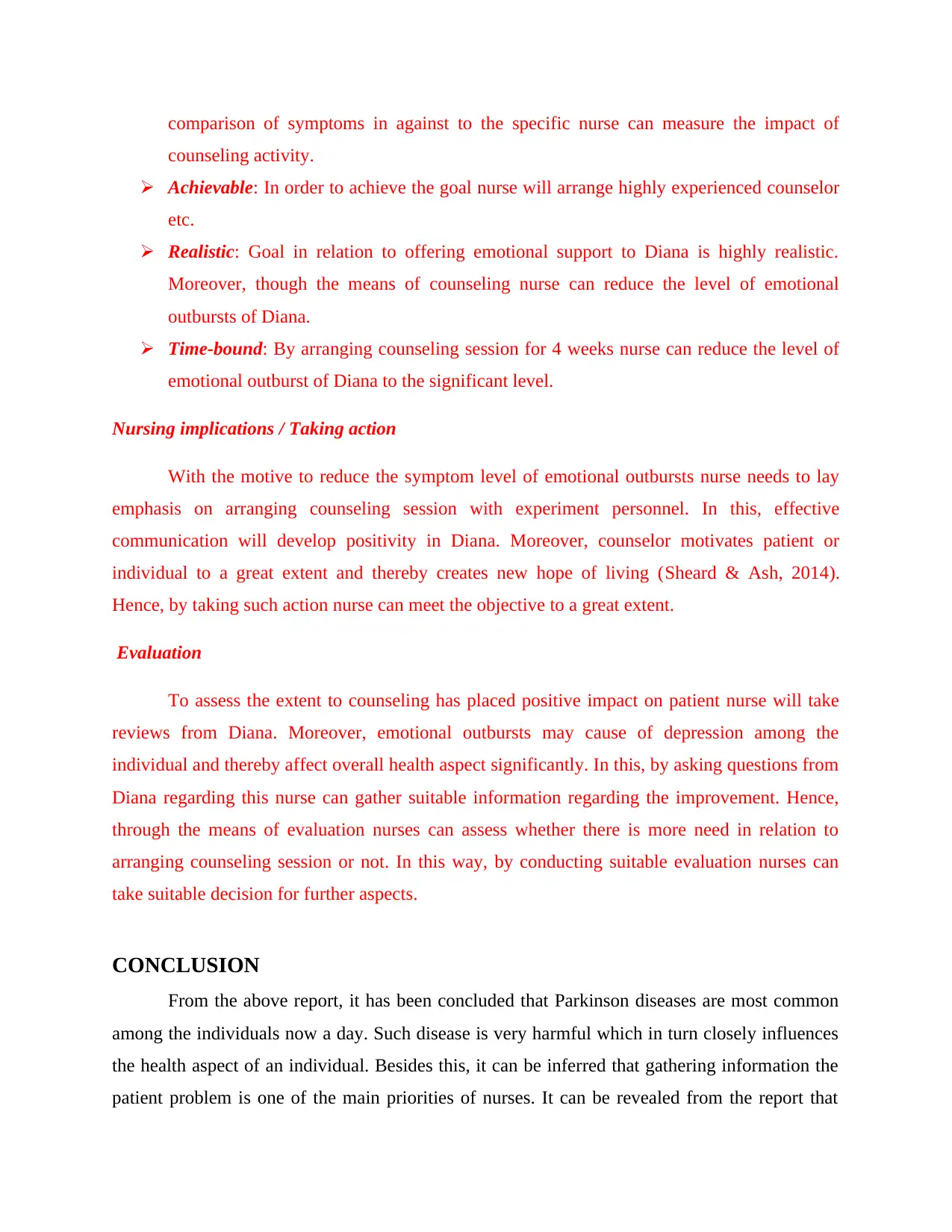Parkinson's Disease Case Study: Symptoms, Nursing Priorities, and Care
VerifiedAdded on 2020/02/12
|9
|1997
|134
Report
AI Summary
This report delves into Parkinson's disease, a chronic movement disorder affecting millions worldwide. It begins by outlining the disease's symptoms, including tremors, bradykinesia, rigidity, and postural instability, and emphasizes the negative correlation between Parkinson's and dopamine production. The core of the report focuses on a case study of Diana, a patient with Parkinson's, and applies Levett-Jones' Clinical Reasoning cycle to establish nursing priorities. The report identifies the priority of minimizing Diana's risk of falls, given her unsteady gait, and reducing emotional outbursts, which can impact her mental health. Specific goals are set, such as reducing fall risk within a week and managing emotional outbursts through counseling within four weeks. The report details nursing implications, including home and fall assessments and counseling sessions, and provides evaluation methods, such as patient and family feedback. The conclusion reiterates the importance of early information gathering, symptom-based care, and appropriate medication to manage the disease's impact.

Paraphrase This Document
Need a fresh take? Get an instant paraphrase of this document with our AI Paraphraser


INTRODUCTION
In recent times, Parkinson disease increases among the individuals with the very high
pace. Statistics show that more than 10 million people worldwide are suffered from Parkinson
disease. Trends regarding such disease present that Parkinson disease increased in the past years
with higher percentage among the men who over the age of 70 years (Is Parkinson’s Disease on
the Rise, 2017). Changes which take place in the environment and lifestyle of individuals is one
of the main reasons due to which level or ratio of Parkinson Disease increased over the time
frame. Hence, with the aim to reduce the level of such disease now government has also taken
initiatives by investing money in projects such as $250,000. Moreover, treatment of such disease
is very costly and thereby impose financial burden on individual. The report is based on the case
scenario of Diana who is suffering from the disease of Parkinson. Hence, report will shed light
on the symptoms which indicates that Diana is suffering from Parkinson disease. Further, it will
develop understanding about Levett- Jones’ Clinical Reasoning cycle. By this, priorities of
nurses can be assessed towards such patients in the best possible way.
MAIN BODY
Stating Parkinson’s disease and its symptoms
Parkinson disease may be defined as a chronic disease which implies for the movement
disorder. In such disease, situation of individual relation to the movements worsen over the time
frame. In this, nerve cells of the brain die which is recognized as neurons. Parkinson disease
closely influences neurons in the brain which is termed as substantia nigra. From assessment, it
has been identified that as Parkinson disease increases then dopamine produced decrease to the
significant level. Hence, it can be stated that such disease and dopamine produced in the brain
are negatively correlated or associated with each other. Due to the decrease in the amount of
dopamine individuals face difficulty in controlling their movements. Symptoms of Parkinson
disease are highly differ from one individual to another (Almeida, O. P. & et.al., 2016). Thus,
main symptoms of Parkinson disease include tremor of hands, arms, legs and face. It entails that
when legs, hands and other body parts of individual shivers then there is a symptom of
Parkinson. Further, bradykinesisa, rigidity and postural instability are the major symptoms that
give clear indication regarding Parkinson disease.
In recent times, Parkinson disease increases among the individuals with the very high
pace. Statistics show that more than 10 million people worldwide are suffered from Parkinson
disease. Trends regarding such disease present that Parkinson disease increased in the past years
with higher percentage among the men who over the age of 70 years (Is Parkinson’s Disease on
the Rise, 2017). Changes which take place in the environment and lifestyle of individuals is one
of the main reasons due to which level or ratio of Parkinson Disease increased over the time
frame. Hence, with the aim to reduce the level of such disease now government has also taken
initiatives by investing money in projects such as $250,000. Moreover, treatment of such disease
is very costly and thereby impose financial burden on individual. The report is based on the case
scenario of Diana who is suffering from the disease of Parkinson. Hence, report will shed light
on the symptoms which indicates that Diana is suffering from Parkinson disease. Further, it will
develop understanding about Levett- Jones’ Clinical Reasoning cycle. By this, priorities of
nurses can be assessed towards such patients in the best possible way.
MAIN BODY
Stating Parkinson’s disease and its symptoms
Parkinson disease may be defined as a chronic disease which implies for the movement
disorder. In such disease, situation of individual relation to the movements worsen over the time
frame. In this, nerve cells of the brain die which is recognized as neurons. Parkinson disease
closely influences neurons in the brain which is termed as substantia nigra. From assessment, it
has been identified that as Parkinson disease increases then dopamine produced decrease to the
significant level. Hence, it can be stated that such disease and dopamine produced in the brain
are negatively correlated or associated with each other. Due to the decrease in the amount of
dopamine individuals face difficulty in controlling their movements. Symptoms of Parkinson
disease are highly differ from one individual to another (Almeida, O. P. & et.al., 2016). Thus,
main symptoms of Parkinson disease include tremor of hands, arms, legs and face. It entails that
when legs, hands and other body parts of individual shivers then there is a symptom of
Parkinson. Further, bradykinesisa, rigidity and postural instability are the major symptoms that
give clear indication regarding Parkinson disease.
⊘ This is a preview!⊘
Do you want full access?
Subscribe today to unlock all pages.

Trusted by 1+ million students worldwide

Stating the priorities of nurses regarding the individual suffering Parkinson disease on the basis
of Levett- Jones’ Clinical reasoning cycle
In accordance with Levett- Jones’ Clinical reasoning cycle starts with the collection of
cues or information by considering the current situation of patients. Moreover, without having
proper information regarding this nurses are not in situation to provide individual with better care
or services (Postuma & et.al., 2016). Hence, it is the accountability of nurses to identify or
collect information from Diana. Thus, nurses are required to collect information about fatigue,
bradykinesia, tremor, emotional outbursts and unsteady gait. By considering such model, it can
be stated that nurses lay emphasis on the collection of information by considering the specific
level or criteria. By this, can identify the level of issues and thereby would become able to
establish goals (Cole & et.al., 2016).
In the given case situation, there are several symptoms which have been experienced by
Diana that entails that she is from Parkinson disease. Out of 12, fatigue level of Diana accounts
for 12 which is not a good indicator. On the other side, bradykinesia, unsteady gait and tremor of
Diana is out of 12. Emotional outbursts of Diana are 12 out of 12 which is not good for her from
the perspective of health (Poortvliet&et,al., 2015). Hence, first nursing priority of the nurse is to
minimizing the risks of fall in Diana by providing suitable care. Moreover, unsteady gait may
result into the risk of fall or injury. Moreover, level of unsteady gait is too high which in turn
creates the risk of physical injury. Further, level of emotional outbursts is also too high which in
turn may cause of depression in the mind of personnel. Hence, it is second main priority of nurse
because issue of emotional outbursts place direct impact on the mental health of individual.
Nursing priority 1
Goals
Specific: The main objectives of is to minimizing the risk of fall in Diana by providing
appropriate care to her.
Measurable: To measure this level, nurse will take feedback from family members.
Further, by making comparison of the current accident level with previous injuries nurse
can measure the outcome.
of Levett- Jones’ Clinical reasoning cycle
In accordance with Levett- Jones’ Clinical reasoning cycle starts with the collection of
cues or information by considering the current situation of patients. Moreover, without having
proper information regarding this nurses are not in situation to provide individual with better care
or services (Postuma & et.al., 2016). Hence, it is the accountability of nurses to identify or
collect information from Diana. Thus, nurses are required to collect information about fatigue,
bradykinesia, tremor, emotional outbursts and unsteady gait. By considering such model, it can
be stated that nurses lay emphasis on the collection of information by considering the specific
level or criteria. By this, can identify the level of issues and thereby would become able to
establish goals (Cole & et.al., 2016).
In the given case situation, there are several symptoms which have been experienced by
Diana that entails that she is from Parkinson disease. Out of 12, fatigue level of Diana accounts
for 12 which is not a good indicator. On the other side, bradykinesia, unsteady gait and tremor of
Diana is out of 12. Emotional outbursts of Diana are 12 out of 12 which is not good for her from
the perspective of health (Poortvliet&et,al., 2015). Hence, first nursing priority of the nurse is to
minimizing the risks of fall in Diana by providing suitable care. Moreover, unsteady gait may
result into the risk of fall or injury. Moreover, level of unsteady gait is too high which in turn
creates the risk of physical injury. Further, level of emotional outbursts is also too high which in
turn may cause of depression in the mind of personnel. Hence, it is second main priority of nurse
because issue of emotional outbursts place direct impact on the mental health of individual.
Nursing priority 1
Goals
Specific: The main objectives of is to minimizing the risk of fall in Diana by providing
appropriate care to her.
Measurable: To measure this level, nurse will take feedback from family members.
Further, by making comparison of the current accident level with previous injuries nurse
can measure the outcome.
Paraphrase This Document
Need a fresh take? Get an instant paraphrase of this document with our AI Paraphraser

Achievable: By taking action plan in relation to dealing with the aspects of unsteady gait
nurse can overcome the issue of unsteady gait.
Realistic: Such goal is realistic because by taking high level of caution nurse can prevent
the risk of fall (Follett & et,al., 2016).
Time-bound: Nurses have accountability to minimize the risk of fall within one week.
Nursing implications / Taking actions
To reduce the risk level nurse needs to make home and fall assessment. By this, nurse
would become able to take suitable provide Diana with suitable care. Hence, nurse is required to
find out the areas of danger in home through the means of home assessment. This in turn enables
nurse to make suitable arrangements for reducing the risk of fall or injury. In addition to this,
nurse will also conduct fall assessment which in turn helps in getting about uneven places. In this
by gathering about all such aspects nurse can give special care to Diana and thereby becomes
able to attain objective.
Evaluation
For making appropriate evaluation of goals nurse will continuous take feedback from the
patient such as Diana. Moreover, Diana has better idea regarding the areas which in turn impose
high risk in front of her regarding falling or injury. Along with this, nurse will take feedback
from the family members of Diana. Moreover, they are not in position to provide suitable
information regarding the level to which risk of fall or injury is reduced. In this way, by
collecting suitable clues or information through the means of feedback nurse can find out the
suitable level of cope up with the situation of unsteady gait (Pringsheim & et,al., 2014).
Nursing Priority 2
Goals
Specific: The main goals of nurses are to reduce the level of emotional outbursts which
are identified above. Hence, control and management of such symptoms can be assured
through the means of counseling.
Measurable: Nurses can measure the impact of counseling by taking feedbacks from the
patient and evaluating the symptoms (Sheard & Ash, 2015). Moreover, by making
nurse can overcome the issue of unsteady gait.
Realistic: Such goal is realistic because by taking high level of caution nurse can prevent
the risk of fall (Follett & et,al., 2016).
Time-bound: Nurses have accountability to minimize the risk of fall within one week.
Nursing implications / Taking actions
To reduce the risk level nurse needs to make home and fall assessment. By this, nurse
would become able to take suitable provide Diana with suitable care. Hence, nurse is required to
find out the areas of danger in home through the means of home assessment. This in turn enables
nurse to make suitable arrangements for reducing the risk of fall or injury. In addition to this,
nurse will also conduct fall assessment which in turn helps in getting about uneven places. In this
by gathering about all such aspects nurse can give special care to Diana and thereby becomes
able to attain objective.
Evaluation
For making appropriate evaluation of goals nurse will continuous take feedback from the
patient such as Diana. Moreover, Diana has better idea regarding the areas which in turn impose
high risk in front of her regarding falling or injury. Along with this, nurse will take feedback
from the family members of Diana. Moreover, they are not in position to provide suitable
information regarding the level to which risk of fall or injury is reduced. In this way, by
collecting suitable clues or information through the means of feedback nurse can find out the
suitable level of cope up with the situation of unsteady gait (Pringsheim & et,al., 2014).
Nursing Priority 2
Goals
Specific: The main goals of nurses are to reduce the level of emotional outbursts which
are identified above. Hence, control and management of such symptoms can be assured
through the means of counseling.
Measurable: Nurses can measure the impact of counseling by taking feedbacks from the
patient and evaluating the symptoms (Sheard & Ash, 2015). Moreover, by making

comparison of symptoms in against to the specific nurse can measure the impact of
counseling activity.
Achievable: In order to achieve the goal nurse will arrange highly experienced counselor
etc.
Realistic: Goal in relation to offering emotional support to Diana is highly realistic.
Moreover, though the means of counseling nurse can reduce the level of emotional
outbursts of Diana.
Time-bound: By arranging counseling session for 4 weeks nurse can reduce the level of
emotional outburst of Diana to the significant level.
Nursing implications / Taking action
With the motive to reduce the symptom level of emotional outbursts nurse needs to lay
emphasis on arranging counseling session with experiment personnel. In this, effective
communication will develop positivity in Diana. Moreover, counselor motivates patient or
individual to a great extent and thereby creates new hope of living (Sheard & Ash, 2014).
Hence, by taking such action nurse can meet the objective to a great extent.
Evaluation
To assess the extent to counseling has placed positive impact on patient nurse will take
reviews from Diana. Moreover, emotional outbursts may cause of depression among the
individual and thereby affect overall health aspect significantly. In this, by asking questions from
Diana regarding this nurse can gather suitable information regarding the improvement. Hence,
through the means of evaluation nurses can assess whether there is more need in relation to
arranging counseling session or not. In this way, by conducting suitable evaluation nurses can
take suitable decision for further aspects.
CONCLUSION
From the above report, it has been concluded that Parkinson diseases are most common
among the individuals now a day. Such disease is very harmful which in turn closely influences
the health aspect of an individual. Besides this, it can be inferred that gathering information the
patient problem is one of the main priorities of nurses. It can be revealed from the report that
counseling activity.
Achievable: In order to achieve the goal nurse will arrange highly experienced counselor
etc.
Realistic: Goal in relation to offering emotional support to Diana is highly realistic.
Moreover, though the means of counseling nurse can reduce the level of emotional
outbursts of Diana.
Time-bound: By arranging counseling session for 4 weeks nurse can reduce the level of
emotional outburst of Diana to the significant level.
Nursing implications / Taking action
With the motive to reduce the symptom level of emotional outbursts nurse needs to lay
emphasis on arranging counseling session with experiment personnel. In this, effective
communication will develop positivity in Diana. Moreover, counselor motivates patient or
individual to a great extent and thereby creates new hope of living (Sheard & Ash, 2014).
Hence, by taking such action nurse can meet the objective to a great extent.
Evaluation
To assess the extent to counseling has placed positive impact on patient nurse will take
reviews from Diana. Moreover, emotional outbursts may cause of depression among the
individual and thereby affect overall health aspect significantly. In this, by asking questions from
Diana regarding this nurse can gather suitable information regarding the improvement. Hence,
through the means of evaluation nurses can assess whether there is more need in relation to
arranging counseling session or not. In this way, by conducting suitable evaluation nurses can
take suitable decision for further aspects.
CONCLUSION
From the above report, it has been concluded that Parkinson diseases are most common
among the individuals now a day. Such disease is very harmful which in turn closely influences
the health aspect of an individual. Besides this, it can be inferred that gathering information the
patient problem is one of the main priorities of nurses. It can be revealed from the report that
⊘ This is a preview!⊘
Do you want full access?
Subscribe today to unlock all pages.

Trusted by 1+ million students worldwide

without having enough or suitable information individual is not in situation to diagnose problem
in an effectual way. Further, it has been articulated that by considering that in the care sector
nurses have accountability to give medicines to the patients on the basis of their symptoms level.
Moreover, suitable drugs and medicines reduce involuntary movements which causes to
Parkinson disease. In this way, appropriate medicines or care helps in reducing the impact of
disease to the significant level.
in an effectual way. Further, it has been articulated that by considering that in the care sector
nurses have accountability to give medicines to the patients on the basis of their symptoms level.
Moreover, suitable drugs and medicines reduce involuntary movements which causes to
Parkinson disease. In this way, appropriate medicines or care helps in reducing the impact of
disease to the significant level.
Paraphrase This Document
Need a fresh take? Get an instant paraphrase of this document with our AI Paraphraser

REFERENCES
Books and Journals
Almeida, O. P. & et.al., 2016. Affective Disorders, Psychosis and Dementia in a Community
Sample of Older Men with and without Parkinson’s Disease. PloS one, 11(9), p.e0163781.
Cole, M. H. & et.al., 2016. Use of a short-form balance confidence scale to predict future
recurrent falls in people with Parkinson disease. Archives of physical medicine and
rehabilitation. 97(1). pp.152-156.
Follett, J. & et,al., 2016. Parkinson Disease-linked Vps35 R524W Mutation Impairs the
Endosomal Association of Retromer and Induces α-Synuclein Aggregation. Journal of
Biological Chemistry. 291(35). pp.18283-18298.
Poortvliet, P. C. & et,al., 2015. Deep brain stimulation for Parkinson disease in Australia: current
scientific and clinical status. Internal medicine journal. 45(2). pp.134-139.
Postuma, R. B. & et.al., 2016. The new definition and diagnostic criteria of Parkinson's
disease. The Lancet Neurology. 15(6). pp.546-548.
Pringsheim, T. & et,al., 2014. The prevalence of Parkinson's disease: A systematic review and
meta‐analysis. Movement disorders. 29(13). pp.1583-1590.
Sheard, J. M. & Ash, S., 2014. Current practice in nutrition assessment for the management of
Parkinson's disease in Australia and Canada. Nutrition & Dietetics. 71(2). pp.92-99.
Sheard, J. M. & Ash, S., 2015. Current practice in nutrition diagnosis and intervention for the
management of Parkinson's disease in Australia and Canada. Nutrition & Dietetics. 72(1).
pp.30-35.
Online
Is Parkinson’s Disease on the Rise. 2017. pdf. Available through: <
http://www.pdf.org/en/science_news/release/pr_1466429901>. [Accessed on 20th March
2017].
Books and Journals
Almeida, O. P. & et.al., 2016. Affective Disorders, Psychosis and Dementia in a Community
Sample of Older Men with and without Parkinson’s Disease. PloS one, 11(9), p.e0163781.
Cole, M. H. & et.al., 2016. Use of a short-form balance confidence scale to predict future
recurrent falls in people with Parkinson disease. Archives of physical medicine and
rehabilitation. 97(1). pp.152-156.
Follett, J. & et,al., 2016. Parkinson Disease-linked Vps35 R524W Mutation Impairs the
Endosomal Association of Retromer and Induces α-Synuclein Aggregation. Journal of
Biological Chemistry. 291(35). pp.18283-18298.
Poortvliet, P. C. & et,al., 2015. Deep brain stimulation for Parkinson disease in Australia: current
scientific and clinical status. Internal medicine journal. 45(2). pp.134-139.
Postuma, R. B. & et.al., 2016. The new definition and diagnostic criteria of Parkinson's
disease. The Lancet Neurology. 15(6). pp.546-548.
Pringsheim, T. & et,al., 2014. The prevalence of Parkinson's disease: A systematic review and
meta‐analysis. Movement disorders. 29(13). pp.1583-1590.
Sheard, J. M. & Ash, S., 2014. Current practice in nutrition assessment for the management of
Parkinson's disease in Australia and Canada. Nutrition & Dietetics. 71(2). pp.92-99.
Sheard, J. M. & Ash, S., 2015. Current practice in nutrition diagnosis and intervention for the
management of Parkinson's disease in Australia and Canada. Nutrition & Dietetics. 72(1).
pp.30-35.
Online
Is Parkinson’s Disease on the Rise. 2017. pdf. Available through: <
http://www.pdf.org/en/science_news/release/pr_1466429901>. [Accessed on 20th March
2017].

⊘ This is a preview!⊘
Do you want full access?
Subscribe today to unlock all pages.

Trusted by 1+ million students worldwide
1 out of 9
Related Documents
Your All-in-One AI-Powered Toolkit for Academic Success.
+13062052269
info@desklib.com
Available 24*7 on WhatsApp / Email
![[object Object]](/_next/static/media/star-bottom.7253800d.svg)
Unlock your academic potential
Copyright © 2020–2025 A2Z Services. All Rights Reserved. Developed and managed by ZUCOL.





